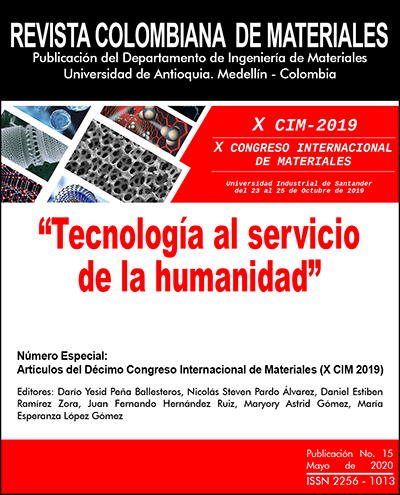Analysis of the mechanical behavior of latex resistance bands as substitutes of human skin in mechanical test
DOI:
https://doi.org/10.17533/udea.rcm.342057Keywords:
human skin, pig skin, latex resistance bands, tension test, hyperelasticityAbstract
The skin is a highly anisotropic multilayer tissue, and the analysis of its characteristics has been studied for decades without finding a definitive model. Nowadays, both models and skin substitutes are needed to supply the necessities in surgery simulators, video games, and animation industry. In this study pig skin samples from a local store were used due to the similarities between the pig and human skin. The hypodermis was removed, and the skin was dissected in specimens of approximately 6 mm x 12 mm. The specimens were tested in a Shimadzu AG-X universal testing machine with three replicates. Having as a reference the tests performed to pig skin, latex resistance bands are proposed as mechanical substitute for human skin and its viability is evaluated in this study. Uniaxial tensile tests were carried out to C-type dumbbell specimens according to ASTM D412 standard using seven latex resistance bands (their rigidity are differenced by colors). The constants for Veronda Westman hyperelastic model for both materials were obtained by an optimization process carried out in FEBio Suite. Using the deformation energy as comparative factor, this kind of band could not replace mechanically human skin in assessing scenarios and applications described above.
Downloads
References
Derler, S. and Gerhardt, L. C., “Tribology of Skin: Review and Analysis of Experimental Results for the Friction Coefficient of Human Skin,” Tribol Lett, vol. 45, no. 1, pp. 1–27, Jan. 2012.
Limbert, G. et al., “Biotribology of the ageing skin—Why we should care,” Biotribology, vol. 17, pp. 75–90, Mar. 2019.
Limbert, G., “Mathematical and computational modelling of skin biophysics: a review,” Proceedings of the Royal Society A: Mathematical, Physical and Engineering Sciences, vol. 473, no. 2203, p. 20170257, Jul. 2017.
Leyva-Mendivil, M. F., Lengiewicz, J., Page, A., Bressloff, N. W. and Limbert, G., “Skin Microstructure is a Key Contributor to Its Friction Behaviour,” Tribol Lett, vol. 65, no. 1, p. 12, Jan. 2017.
Zhong, W., Xing, M. M. Q., Pan, N.,and Maibach, H. I.,“Textiles and human skin, microclimate, cutaneous reactions: An overview,” Cutaneous and Ocular Toxicology, vol. 25, no. 1, pp. 23–39, 2006.
Schwartz, D., Magen, Y. K., Levy, A., and Gefen, A., “Effects of humidity on skin friction against medical textiles as related to prevention of pressure injuries,” Int Wound J, vol. 15, no. 6, pp. 866–874, Dec. 2018.
Carlson, J. M., “Functional limitations from pain caused by repetitive loading on the skin: A review and discussion for practitioners, with new data for limiting friction loads,” JPO: Journal of Prosthetics and Orthotics, vol. 18, no. 4, pp. 93–103, 2006.
Sopher, R. and Gefen, A. “Effects of skin wrinkles, age and wetness on mechanical loads in the stratum corneum as related to skin lesions,” Med Biol Eng Comput, vol. 49, no. 1, pp. 97–105, Jan. 2011.
Tran, H. V., Charleux, F., Rachik, M., Ehrlacher, A., and Tho, M. C. Ho Ba, “In vivo characterization of the mechanical properties of human skin derived from MRI and indentation techniques,” Computer Methods in Biomechanics and Biomedical Engineering, vol. 10, no. 6, pp. 401–407, 2007.
Gerhardt, L.-C., Strässle, V., Lenz, A., Spencer, N. D., and Derler, S., “Influence of epidermal hydration on the friction of human skin against textiles,” Journal of the Royal Society Interface, vol. 5, no. 28, pp. 1317–1328, 2008.
Lapeer, R. J., Gasson, P. D., and Karri, V., “A hyperelastic finite-element model of human skin for interactive real-time surgical simulation,” IEEE Transactions on Biomedical Engineering, vol. 58, no. 4, pp. 1013–1022, 2011.
Lapeer, R. J., Gasson, P. D., and Karri, V., “Simulating plastic surgery: From human skin tensile tests, through hyperelastic finite element models to real-time haptics,” Progress in Biophysics and Molecular Biology, vol. 103, no. 2–3, pp. 208–216, 2010.
Renvoise, J., Burlot, D., Marin, G., and Derail, C., “Adherence performances of pressure sensitive adhesives on a model viscoelastic synthetic film: A tool for the understanding of adhesion on the human skin,” International Journal of Pharmaceutics, vol. 368, no. 1–2, pp. 83–88, 2009.
Derler, S., Schrade, U. and Gerhardt, L.-C. “Tribology of human skin and mechanical skin equivalents in contact with textiles,” Wear, vol. 263, no. 7–12, pp. 1112–1116, Sep. 2007.
Lim K. H., et al., “New extensometer to measure in vivo uniaxial mechanical properties of human skin,” Journal of Biomechanics, vol. 41, no. 5, pp. 931–936, 2008.
Shergold, O. A., Fleck, N. A., and Radford, D., “The uniaxial stress versus strain response of pig skin and silicone rubber at low and high strain rates,” International Journal of Impact Engineering, vol. 32, no. 9, pp. 1384–1402, Sep. 2006.
Martins, P., Natal Jorge, R. M., and Ferreira, A. J. M., “A Comparative Study of Several Material Models for Prediction of Hyperelastic Properties: Application to Silicone-Rubber and Soft Tissues,” Strain, vol. 42, no. 3, pp. 135–147, 2006.
ASTM, ASTM D412-06a(2013), Standard Test Methods for Vulcanized Rubber and Thermoplastic Elastomers—Tension. West Conshohocken, PA,: ASTM International, 2013.
Veronda, D. R., and Westmann, R. A., “Mechanical characterization of skin—Finite deformations,” Journal of Biomechanics, vol. 3, no. 1, pp. 111–124, Jan. 1970.
Maas, S. A., Ellis, B. J., Ateshian, G. A., and Weiss, J. A., “FEBio: Finite Elements for Biomechanics,” J Biomech Eng, vol. 134, no. 1, pp. 011005-011005–10, Feb. 2012.
Downloads
Published
How to Cite
Issue
Section
License
Copyright (c) 2020 Revista Colombiana de Materiales

This work is licensed under a Creative Commons Attribution-NonCommercial-ShareAlike 4.0 International License.








